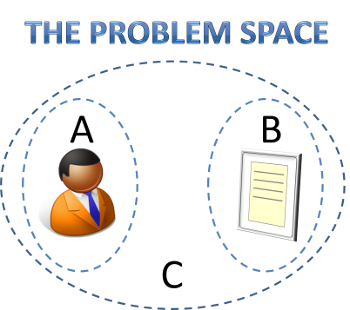Table of Contents
The Problem Space
Introduction
The problem domain is defined when a client expresses a notion that they have a specific problem and they describe it with themselves as part of it. They are in a problem space, defined by a boundary. For this purpose we shall call this an egg-type problem.
Figure 9
An Egg Problem
When the facilitator only works within the boundary of the problem domain, they will be looking for egg-type solutions. When a traumatic experience is the issue, and it is worked on within its problem domain, the issue may seem to be resolved and some healing will occur but soon the next issue will arise.
It may be surprising that the resolution of the first issue hadn’t had more of an effect on other issues in the person’s life. Egg solutions will only solve egg problems. What is needed is a solution that encompasses all the eggs.
This needs to come from outside the boundary, in other words and in a metaphorical sense, a farming solution.
A Farming Solution
To find the farming solution, the difficulty is getting outside of the boundary the eggs are in. The techniques of clean language, clean space and emergent knowledge will do this by either pulling the person back in time and space or by physically moving the person from the problem space (where they are sitting or standing in the room).
A few simple questions to solve the egg problem would be:
- “Where did this egg come from before it was this egg?”
- “What kind of egg was this egg before it was this egg?”
Generalising the Solution
And, when transposing ‘problem’ for ‘egg’ in the preceding questions:
- “Where did this problem come from before it was this problem?”
- “What kind of problem was this problem before it was this problem?”
The client starts with a problem set, or a particular class of problems and the solution set will be in a completely different cosmology. This is how the concept of emergent knowledge works. It moves the person out of their problem domain.
We can elicit some information about how the client classifies their problems, once the client has written or drawn their statement, we can ask:
- “What do you call that?” indicating towards the statement.
This also assist us when discovering the Pristine aspect of the problem, we simply exchange the answer to the above question into either of the egg questions.
- “And where did this …… come from before it was this ……?”
- “And what kind of …… was this …… before it was this ……?”
A client’s problem space is where they are focussed on the trauma and the events that occurred. When they begin to talk about the trauma they will be in a time period that begins just before the worst moment occurred. It is characterised by the use of words ending in ‘ing’ that keeps the problem ongoing.
